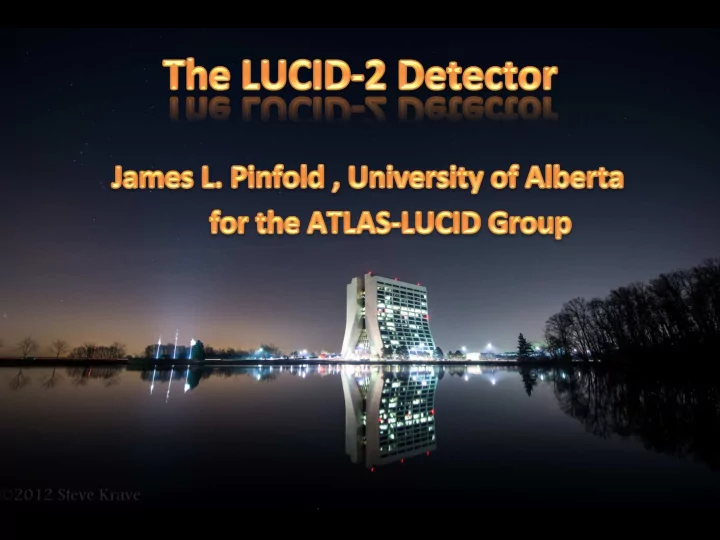

• LUCID is a Cerenkov detector sensi3ve to par3cles from the LHC-collisions. It is composed of two modules around the beam-pipe at ±17m from from the ATLAS IP
All PMTs calibrated wih Bismuth for 2017 Hamamatsu R760 PMT Hamamatsu R760 PMT • Sensors – 4 groups of 4 PMTs – 4x10 mm window PMTs (calib. 207 Bi) – 4x10 mm window PMTs (calib. with 207 Bi) – 4x7mm reduced window (calib.with 207 Bi – 4x10 mm spare PMTs (calib. with 207 Bi – 4 quartz fibre “calos” readout by PMT in LUCID readout fibres. low radia3on area (CALIB. WITH LEDS)
• 4 custom-made VME boards (LUCROD) placed ±17 m from the PMTs provide hit coun3ng and charge measurement (insensi3ve to pile-up & prop. to lumi.) at each bunch crossing. – FPGAs integrate PMT signals over each bunch crossing • 2 LUMAT boards correlate hits from each side of LUCID to produce online and offline lumi measurements based in 12 algos
• PMTs test to 200 kGy using the CALLIOPE 60 Co source and… • PMTs tested up to ~ 2.6 x 10 14 n/cm 2 using the TAPIRO facility • This is the radia3on dose expected for LHC RUN-2 • No obvious radia=on effects on the PMTs
2015/2016 • All PMTs now calibrated with ~1 MeV electrons from 207-Bi internal conversion • Fibres Calos: now calibrated with LED pulses (stability monitored by Pin Diode)
Internal e- 207 Bi calibraFon trending plot conversion 207 Pb 207 Bi 207 Bi Electron 5% gain stability ⟺ 1.5% luminosity stability capture 5% gain stability ⟺ 1.5% luminosity stability e- ATL-FWD-PROC-2016-001 Energy ~ 1 MeV 207 Bi now deposited on the window of all PMTs • – Intensity of source is small compared to expected event rate but enough to calibrate in a few minutes when there are no interac3ons in ATLAS
Bi-207 dies not spoil the precision of the VdM scan • Calibra3on: – The absolute calibra3on constant is measured for each algorithm and sensor type during dedicated LHC fills – The Van der Meer (VdM) scan technique is used (sweeping beams transversely across each other in a simple x/y scan (RH diagram)
(BCM) • LUCID-2 Exploits 2 Different kinds of algorithm: – Hit and event coun=ng algorithms e.g. EventOR ( n hit ≥ 1 in detector) Detected mean number of hits/events Calibra3on constant obtained from The VdM scan – Charge Integra=ng algorithms : measurement of the charge in the PMTs - propor3onal to luminosity. Charge measured by PMT
5 > -1 [%] ATLAS Preliminary 4 Data 2015 s = 13 TeV LUCID 3 µ >/< 2 Algo µ 1 < 0 1 − BCM 2 − LUCID-ORC − 3 LUCID-AND − 4 TILE CALORIMETER 5 − 100 200 300 400 500 600 700 Time [minutes] • LEFT - Comparison of methods of lumi determina3on in ATLAS • RIGHT - Ra3o of µ the <#inelas3c pp collisions/bunch crossing> from different ATLAS luminometers, to that reported by the forward (A) arm of the LUCID detector: – The backward arm of LUCID (LUCID-ORC), – The LUCID coincidence algorithm (LUCID-AND) – The luminosity determined by the TILE calorimeter (consistent within ±0.4% or bemer). – The BCM detector underes3mate the luminosity by as much as 2 % early in the fill.
Error on ATLAS luminosity in 2015 VdM CalibraFon LUCID uncertainty Preliminary es3mate of lumi. error in 2016 ~ 2.2%
• An accurate determina3on of the luminosity is essen3al in any high-energy physics experiment providing cross-sec3on measurements. • The change of LHC running condi3ons for 13 TeV running has required a complete LUCID redesign of detector & electronics – hence LUCID-2. • Currently, LUCID-2 provides the official luminosity figures for ATLAS. – Preliminary results of the analysis shows a long-term stability of the LUCID at the level of ~1% and a total systema3c uncertainty on luminosity measurement of ~2% • Thanks to the different detec3on methods implemented, LUCID-2 is expected to provide important inputs for the luminosity detector for Hi luminosity LHC (~2025)
Recommend
More recommend